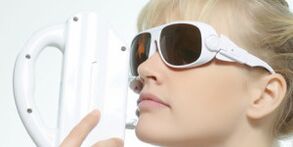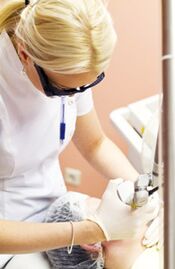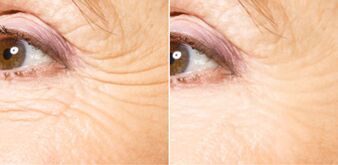
Skin aging begins at age 25, and initially the process goes unnoticed.At the same time, the skin gradually loses elasticity, changes its structure, becomes loose, enlarged pores, and wrinkles appear.Sooner or later, the changes will become noticeable, and then it will be difficult to deal with them with ordinary cosmetics.And pigmentation disorders and skin thinning simply cannot be corrected through conservative methods.
Fortunately, modern technology doesn’t leave us alone with the problem of fading.To restore youthful skin, it's not enough to simply eliminate existing imperfections and signs of aging.It must be stimulated and initiate the cell renewal process.Only in this way can we not only achieve visual effects, but also achieve real facial rejuvenation.Fractional laser facial rejuvenation, which has been used in the cosmetic field for more than 10 years, can solve such problems.
The technology is based on a segmented photothermolysis approach - exposure to a laser beam of a certain length, divided into multiple optical streams (segments) to allow for more efficient operation.Today, fractional rejuvenation is considered a real alternative to surgical facelift.
The mechanism of action of laser fractional facial rejuvenation
Over time, all processes in the body slow down, including at the cellular level.This is what causes skin aging: cells no longer regenerate as quickly, new cells no longer actively grow, and as a result, skin renewal becomes increasingly ineffective or even stops.Research shows that laser exposure to its cells helps restore the skin's natural regenerative potential.
Under the influence of the beam and the thermal shock it creates in the skin, a deep tissue cleansing is carried out of already dead cells and those that have lost the ability to grow and develop further.At the same time, young and healthy cells only benefit from the effect that they actively reproduce, replace used cells and restore "destroyed" skin renewal mechanisms.
Almost all cosmetic lasers have this effect on facial skin.Fraxel is different in that it uses the most effective laser beam size, less than 200 microns in diameter: it is this thin laser that is most beneficial in replacing old tissue with younger, healthier tissue.
The second characteristic of lattice rejuvenation is that the effect is produced not by a single beam of light, but by the entire mass of microrays in which the light flux is divided, thus producing a grid effect.Therefore, irradiation occurs neither point by point nor in continuous pulses.It is positioned according to a certain matrix.
The skin is divided into small areas, and each area has tissue in the center that has been subjected to an intense thermal shock, surrounded by healthy cells that have not been affected by the laser beam.The result of this treatment is active skin regeneration: exfoliation of damaged cells and growth of younger skin.
Types of dot matrix rejuvenation
Fractional photothermolysis exists in two fundamentally different forms: ablative and non-ablative.These laser treatments differ from each other in a number of characteristics: depth of laser penetration, intensity of treatment, mechanism of skin stimulation and final effect.
Ablative techniques involve superficial effects on epidermal cells through evaporation.In contrast, non-ablative rejuvenation does not affect the topmost layers of the skin, but rather penetrates deeper into the skin, where the subepidermis is located and where the dermis begins.In this case, the irradiated cells do not evaporate but form columns of coagulated tissue.
In both cases, laser treatment occurs in limited areas around which so-called cell programming zones are preserved - healthy cells with huge regenerative potential, which are triggered by heat shock.A short-term increase in tissue temperature activates all metabolic processes within it, including the growth of elastin and collagen fibers, which are responsible for the elasticity and rejuvenation of the skin.
Ablative Fraxel works quickly and is better suited for eliminating the first signs of aging: shallow wrinkles, slight sagging.As a result of the ablation, the microareas evaporate from the skin surface and during the regeneration process, with the participation of cells from the surrounding areas, the skin is covered with new skin.As a result, the facial skin is overall lifted (tightened) and wrinkles and imperfections are eliminated.
To solve the problem of a person with obvious signs of fading, such a surface effect is not enough.Aging skin needs to be "treated" from within, i.e. the deeper layers where the cells responsible for renewing the dermal framework are located.Non-ablative fractional rejuvenation ensures this result.
Of course, no one prohibits combining the two approaches.Then the effect will be even more amazing: the skin will be subject to a dual rejuvenation impulse from the inside out, so the facial condition will be significantly improved after one operation, and the activated tissue renewal will keep the face's "shape" for a long time.
Fractional laser skin rejuvenation surgery
Like any other laser procedure, Fraxel should only be performed by a qualified specialist.In fact, the equipment used refers to medical laser equipment, and one must have medical education, training and experience to use this equipment.
If in the wrong hands, lasers can become dangerous due to complications and unpredictable consequences.In addition, the procedure has considerable contraindications.Preparation for fractional rejuvenation should begin by identifying barriers to the use of laser surgery.
Contraindications
We list conditions and diseases that do not allow laser surgery:
- the presence or absence of any tumor formation in the body now and in the past;
- Skin diseases at the treatment site: dermatitis, skin diseases, eczema, psoriasis, vitiligo;
- Damage to the skin (abrasions, scratches);
- Have a history of photosensitivity;
- Tendency to form keloids;
- Chronic diseases of endocrine, cardiovascular and blood systems;
- acute viral and bacterial infections;
- Weak immunity;
- Acute or chronic herpes acute phase;
- taking retinoid-based medicines (after the end of treatment, at least six months must pass if tablets are used, and at least two weeks if topical medicines are used);
- Pregnancy, breastfeeding;
- epilepsy and other psychiatric and neurological problems;
- Recently tanned
After studying the medical history and current health status, the beautician decides on the possibility of performing the procedure.In some cases, temporary postponement is necessary, such as during a cold or during menstruation.Generally speaking, fractional laser skin rejuvenation is a fairly safe procedure that does not cause any complications if done correctly.

Program progress
Fractional photothermal treatment is considered a painless procedure.However, this cannot be said 100%.Most patients still experience discomfort during and especially after laser rejuvenation.
Therefore, local anesthesia is usually used to start laser treatment.An anesthetic is applied to the face to reduce overall skin sensitivity.Burning and stinging sensations are acceptable during exposure to pulses.
Facial treatment takes 20-40 minutes (session time depends on the size of the treatment area), upon completion a special protective cream is applied to the skin, and the patient receives advice on facial skin care during recovery.
Skin regeneration after surgery

It is believed that Fractional Rejuvenation requires no recovery period and does not disrupt the normal rhythm of life.In fact, this is not entirely true.To avoid getting into an embarrassing situation, it is best not to take risks and not try to combine laser surgery with work or an upcoming vacation.It is recommended to take at least a week's rest, since during these days you need to follow a rest regime and your appearance is unlikely to allow you to live an active life.The face will be red and swollen for several days, and the skin will begin to peel after a few days. It will take 7-10 days to look normal.
Treatment with ablative Fraxel can be particularly unpleasant: with it, facial conditions can resemble burns.Other consequences after surgery include:
- Hyper- or hypo-pigmentation;
- The appearance of scars and scars, if their tendency was not noticed before;
- Introduce infection into microwounds.
This side effect is unlikely to occur and occurs in less than 3% of all Fractional Rejuvenation cases.If the surgery itself is performed correctly, without interfering with the preparation and recovery process, the likelihood of complications is reduced to zero.
After fractional laser treatment, you should not sunbathe, subject your skin to friction, use harsh cosmetics, or be too hot or cold.
Fractional laser facial rejuvenation effects
Unlike fractional resurfacing, fractional laser rejuvenation is a minimally invasive procedure.It doesn't "burn" the skin layers, so the results after one session are unlikely to be amazing.Typically, staged rejuvenation is performed over 3 to 6 sessions, after which you can evaluate the results:

- tightens and tightens the skin;
- Strengthen oval face;
- smooth wrinkles;
- Eliminate pigment spots;
- After smoothing acne;
- Evens skin tone.
The rejuvenating effects can last from one year to ten years, and you can then repeat the process.
Fractional laser rejuvenation is also suitable for other procedures during recovery after plastic surgery: peels, injection techniques.Laser irradiation does not have a damaging effect on previously introduced fillers, but experts believe that it is best to undergo a full course of Fraxel before starting to correct remaining defects.
As for patient reviews, they're mixed.In addition to positive recommendations for the procedure, negative remarks are often found.Therefore, many women make the following complaints:
- The recovery period was much longer than the beautician promised.Generally speaking, what we are talking about is not the 4-7 days mentioned by the beauty salon staff, but about 10-14 days.
- More than half of patients reported inadequate efficacy.Many people find that fractional rejuvenation makes their face puffy, causing them to look older than before the procedure.It's also worth noting that the procedure's ability to smooth wrinkles has been greatly exaggerated, with its primary purpose being to eliminate pigmentation and acne marks.
- The undoubted disadvantage of fractional laser rejuvenation is its cost.
Comments about the program
Here are some reviews about fractional laser facial rejuvenation:
Review #1
My husband and I gave my mother-in-law a Dot Rejuvenation certificate to celebrate our anniversary.She was a young, active woman and she went happily.The result is clear: the face is refreshed and firmed, various imperfections disappear, wrinkles around the eyes are visibly smoothed.She only did it once, but she wanted to go again to solidify the results and ask for the same gift next vacation.
Comment #2
I don't like fractional rejuvenation.First, I was miserable.Secondly, I was forced to stay home for nearly two weeks after the surgery.My face became several times bigger, red and even wet, as if pus was oozing out.The result is zero.My main problem is acne on my cheeks.So keeping everything the same, it was worth the pain and for my own money.
Comment #3
I only had enough money for a fractional surgery.Still a bit expensive and unpleasant.But after 6 days I saw the results and they were great!The nasolabial folds are gone and all the age spots are gone, which is what makes me look much older than I am.Now I am satisfied with everything and I think I will decide to take the course again if necessary.
price
As for the cost of a fractional laser skin rejuvenation procedure, it varies greatly based on the workload and level of intervention.Payments are typically set for individual areas, the entire face, including the neck and décolletage.Prices may vary by city.
Most estheticians consider this procedure a valuable alternative to plastic surgery, but when undoing visible changes in the skin is already difficult and expensive, it makes sense to perform this procedure without waiting for major changes to the skin.If you start fractional rejuvenation at age 35-40, this will allow you to postpone more aggressive methods for a long time.

























































